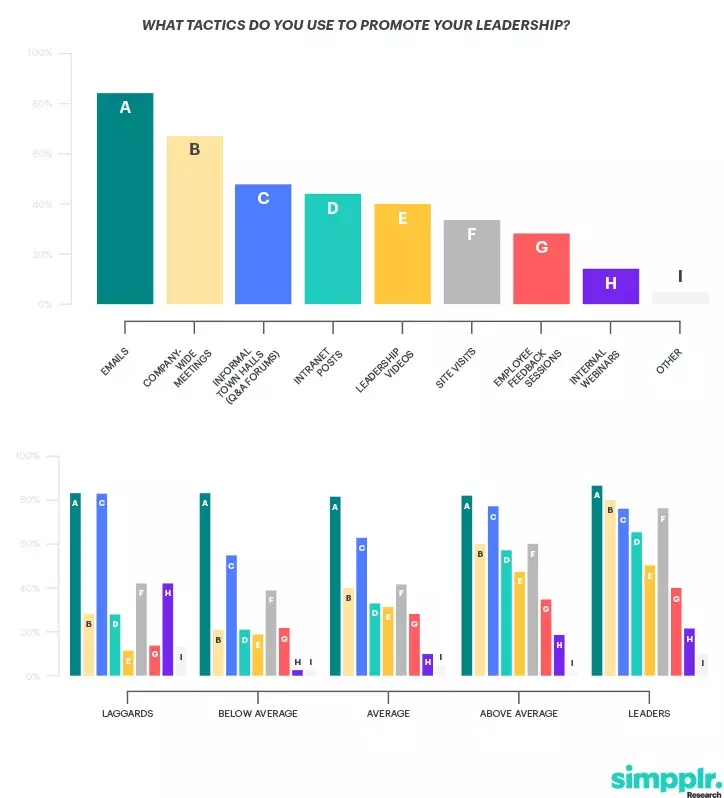Simpplr Research just concluded our latest report, State of Internal Communications 2019. The goal of the survey was to gauge the state of internal communications (IC) profession and help organizations gain insights on how to improve their IC programs. This week, Simpplr Research shares insights on which tactics you should use to most effectively promote your leadership based on organizations with leading internal communications programs.
How do the best internal communications teams promote their leadership?

Data Analysis: The top chart shows the overall distribution of tactics that companies use to promote their leadership. The bottom chart shows the breakdown of this distribution by internal communications quality. The overall chart shows that email is the most popular tactic used by internal communications to promote leadership. Over 80% of organizations use email to promote leadership. This is almost 20% more used than the next most used tactic, company-wide meetings (60%). After these, informal town halls and intranet posts are frequently used respectively, with about half of organizations using each tactic to promote leadership. The least used tactics are internal webinars, employee feedback sessions, and site visits, which are used by 10%, 20% and 25% of organizations, respectively. The breakdown on the bottom has few clear patterns regarding which tactics are used most by internal communications leaders, though it is interesting to note that leaders seem to use site visits much more than the average. Rather, almost every communication tactic has an increasing trend in internal communications technology. This suggests that, rather than using a particular strategy, leaders in internal communications use a mix of strategies to promote their leadership.
Leadership involvement is critical for internal communications success
Based on our research, leading internal communications programs have extremely engaged leadership. Simpplr Research found that there is a drastic difference in IC programs where there is executive involvement compared to programs that lack executive engagement. Organizations with leading IC programs are supported by leaders who constantly beat the drum and remind employees of priorities and goals. In contrast, organizations with lagging IC programs lack the executive involvement needed to unite employees across the board. IC teams need to sell and involve executives more strategically because IC success depends on company alignment. We know from our previous research that alignment is a key driver of employee engagement.
Focus on multiple channels to promote leadership communications
The chart above shows an overwhelmingly high usage in using email as the main channel of communications across organizations. What the chart doesn’t show is the effectiveness of using email as a single channel for leadership communications. The second chart below breaks down the technologies used by organizations segmented down by the quality of internal communications programs from laggards to leaders. Although email is consistently used across all kinds of organizations, this does not infer that your organization should focus on email as a single channel for your internal communications program. In fact, if you compare the laggards to leaders charts in the below chart, you’ll see that leaders disproportionately use all channels to promote their leadership compared to laggards that focus on two channels of communications.
When evaluating your internal communications program, it makes sense to broadcast leadership to as many channels as possible because it extends coverage and covers all employee touchpoints. Organizations with leading internal communications programs communicate much more frequently across channels than organizations with average internal communications programs. Based on the research above, the fear should not be over-communicating, but rather under-communicating. Promoting your leadership is important to the overall company not only improves your internal communications program, but it also unifies your workforce, and as a result, improves company alignment.
Apply the best internal communications tactics today
Because the success of your internal communications program is dependent on leadership involvement, it’s important to actively engage and promote leadership. Based on our research, employ a mix of the following tactics:
- Send emails
- Hold company-wide meetings
- Conduct Informal town halls / Q&A Forums
- Post in the intranet
- Deploy site visits
- Collect employee feedback
- Schedule internal webinars
Remember, the point is to cover all your bases! What other internal communications tactics do you use to effectively promote leadership?














